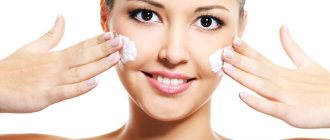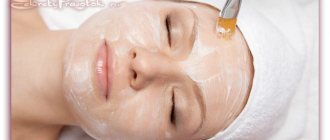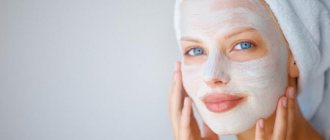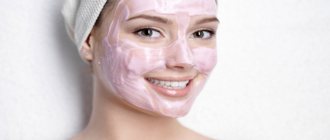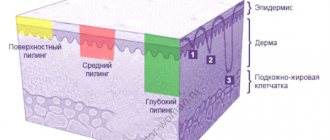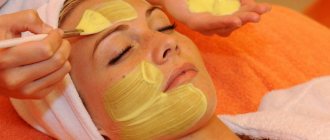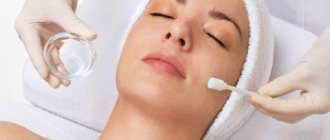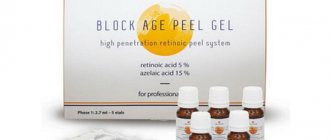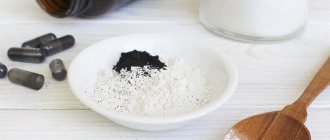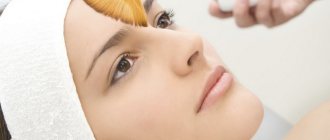The essence of the procedure
Exfoliation is necessary to ensure regular exfoliation of the top layer of skin. Lemon is recommended for its citric acid content. It cleanses the top layer of skin from dirt, sebum and dead cells. Citric acid tightens pores and tightens the oval of the face.
In home cosmetology, fresh lemon slices, juice, and peel are used. Powdered synthetic citric acid is not good for the skin. For the exfoliation procedure, lemon is combined with other components, achieving the consistency of a scrub. Natural abrasives include ground coffee, oatmeal, fine salt, and soda. The binding element can be starch or honey.
Attention! The proportions of ingredients are the same for any recipe: abrasive, binder and lemon are taken in equal quantities.
Benefit and effectiveness
In addition to citric acid, citrus contains:
- bioflavonoids rutin (vitamin P) and hesperidin, which increase the strength of blood vessels and capillaries, penetrating deep into the dermis through the pores;
- phytoncides with antibacterial and antiseptic properties;
- ascorbic acid, which effectively whitens age spots and promotes rejuvenation of the epidermis.
Citric acid loosens the upper layer of the epidermis, cleansing it of keratinized dead cells, stimulates cellular respiration, launching the processes of collagen fiber synthesis.
Lemon-based peeling can quickly lighten the skin, as well as:
- narrow enlarged pores;
- get rid of comedones by dissolving sebaceous plugs;
- smooth out wrinkles, tighten the oval of the face.
After lemon exfoliation sessions, the face immediately looks rested and fresh. The essential oil contained in the peel will relieve fatigue and lift your spirits.
Indications for use
Like any product, lemon can help some and harm others.
Indications for use of lemon peeling:
- noticeable “fatigue” of the skin;
- the first signs of aging;
- dirty and clogged pores;
- tendency to pimples, acne and other inflammations;
- dark spots.
Lemon peeling may be harmful to sensitive skin. In case of excessive dryness, the peeling composition should include softening and moisturizing components. But it is better to consult a cosmetologist before the procedure.
Contraindications to the lemon peeling procedure
The use of lemon peeling requires compliance with certain precautions:
- Do not apply the lemon exfoliation mixture to irritated, damaged skin;
- If there are inflamed acne, open ulcers, peeling can aggravate the problem;
- The presence of rosacea is a contraindication to this type of procedure;
- Dry skin reacts very poorly to citric acid, keep this in mind;
- It is forbidden to injure the epidermis in case of skin diseases: herpes, dermatitis, neoplasms, etc.;
- Refrain from the desire to renew your skin if you are allergic to C6H8O7 acid;
- The procedure is not recommended for pregnant and lactating women;
- Infectious diseases are also a contraindication to lemon peeling.
You should not do the procedure using a ready-made exfoliation mixture with C6H8O7 during solar activity. At least a week before the active application of the mixture, you cannot use scrubs, perform mechanical facial cleansing, etc.
Stages of implementation
During the procedure, you should adhere to the following sequence of actions:
- Selecting the right ingredients. Individual intolerance to products is taken into account, and the current skin condition is assessed. The purpose of the procedure is determined: getting rid of blackheads, tightening the oval of the face or preventive measures.
- Preparation of the mixture. All ingredients are thoroughly mixed to a homogeneous mass of such consistency that it is convenient to apply to the face. If it is too liquid, it will run off; if it is too thick, it will be impossible to distribute evenly.
- Skin preparation. The face is cleansed of decorative cosmetics and dirt in the usual way. Then we take a steam bath, that is, we hold our face over a container of boiling water, covered with a towel.
- Skin moisturizing. Apply moisturizer, avoiding the area around the eyes and lips.
- Applying peeling. Apply the mixture evenly to the entire face and leave for the required time. The time is determined according to skin type. The drier the skin, the shorter the procedure, and vice versa.
- Washing off the mixture. The remaining mixture is washed off with warm water.
- Applying moisturizer.
Regardless of skin type, moisturizer is applied to the face.
Those with oily skin can carry out the procedure once or twice a week, dry skin - once every two weeks.
Whether to peel or not depends on the time of year. In the summer, one of the layers of the skin, the dermis, easily becomes dry from the sun. Therefore, during hot, clear days, you should avoid deep cleansing, as this will increase skin sensitivity. However, those with oily and problematic skin, when regular care does not provide the necessary cleansing, tolerate the procedure well at any time of the year.
Preparation for the process
The main rule of preparation before any type of chemical peeling is a mandatory test for allergic reactions.
If you decide to care for your skin using a ready-made industrial product, then follow the manufacturer’s instructions and recommendations for the preparatory stage. Typically, pre-peeling care before any fruit chemical procedures consists of preparing the skin for the action of acid by using special pre-peeling gels. But often manufacturers of fruit exfoliation products offer mixtures that do not require special skin preparation.
On prepared skin, that is, cleansed of cosmetics, apply lemon peeling with a brush and leave on the skin according to the manufacturer's instructions. Apply the neutralizer on top of the mixture for 1 minute, then rinse with water. After completing the procedure, it is strongly recommended to apply an active mask, which will enhance the peeling effect. But it is imperative to apply a moisturizer with a skin-soothing effect after exfoliation.
Cooking recipes
The most popular options for preparing the peeling composition:
Lemon oil peeling
- 3 tablespoons of freshly squeezed lemon juice;
- 2 tablespoons warm water;
- 1 spoon of any vegetable oil.
The composition is thoroughly mixed and applied with a special brush or cotton swab. Leave on face for 15 minutes and wash off with water. This peeling is recommended as a preventative measure in the fight against aging.
Sugar peeling
Ingredients:
- 2 spoons of sugar;
- 4 tablespoons lemon juice.
Dissolve the sugar in the juice completely. Apply to face and leave until completely absorbed, about 10-15 minutes. The remaining mixture is removed with a dry cloth. The composition helps fight excess shine.
Lemon peeling with gelatin
Ingredients:
- 1 false edible gelatin;
- 2 tablespoons lemon juice;
- 3 spoons of orange juice.
Mix all ingredients and place in a water bath until the gelatin is completely dissolved. Cool to room temperature and apply to face. After 20 minutes the mixture will dry. Remove the cured film. This peeling, similar to a mask, helps eliminate fine wrinkles.
Lemon-honey peeling
Ingredients:
- 2 spoons of honey;
- 1 spoon of lemon juice;
- half a spoon of oat bran.
The honey is melted to a liquid state. Juice and cereal are mixed into it. The mixture is applied to the face and left for 20 minutes. Then it is washed off with water. This peeling is ideal for sensitive skin. Relieves irritation and calms.
Peeling for dry skin
Ingredients:
- grated zest of 2 lemons;
- 1 spoon of vegetable oil.
Everything is mixed and applied to the face. After 15 minutes it is removed with water. Suitable for tired, dull skin.
Beneficial properties of citric acid
It is important to understand the difference between commercial citric acid, which comes as a white, soluble crystalline powder, and the natural acid found in fruits and some vegetables.
Both options are excellent for exfoliating the skin, thanks to their strong cleansing, whitening and bactericidal properties. Today, the substance C6H8O7 is obtained through industrial biosynthesis. As for the antioxidant properties of this substance, it does not require proof, since everyone knows that citric acid is used in the food industry as the most effective antioxidant, preservative and stabilizer. Cosmetologists have also taken this valuable quality of the E330 food additive into service as a weapon in the fight against free radicals that negatively affect the skin, aging it.
In addition to protecting against external negative influences, this natural or synthetic product activates the natural process of collagen production.
This substance – fibrillar protein – is “responsible” for the firmness and elasticity of the integument. In addition, citric acid has a very positive effect on metabolic processes on the skin, stimulating cell renewal. https://youtu.be/https://www.youtube.com/watch?v=sx8f6qy10QY
_
Precautionary measures
Any peeling is best done before bed. In case of allergies, the skin will calm down overnight. The procedure cannot be performed once and wait for results. To achieve the effect, it is necessary to carry out a course of at least 6 procedures. At the end of the course, you need to use sunscreen to avoid damage to the epidermis.
Contraindications include:
- open wounds on the face;
- inflammation or skin disease;
- allergy to citrus fruits.
Advantages and disadvantages
If you peel at home, it has a number of advantages:
- no outside help or special skills are required;
- after the procedure there is no need to go outside, the skin will not be exposed to external influences;
- do peeling whenever you want, regardless of the availability of an appointment in the salon.
Attention! The only disadvantage of lemon peeling is that the result is invisible after one or two procedures. It will be possible to feel the difference after the full course.
How to care for your skin after procedures
There is another important point: ensuring skin protection after exposure to acid-fruit peeling. For some time it will become overly sensitive to external influences. In this regard, after you have peeled with lemon juice, you should not immediately go out into the open sun (as already mentioned).
A few minutes after performing acid peeling, it won’t hurt to wipe your face with an ice cube to narrow the cleansed pores. And it is very advisable to nourish it with a small amount of light moisturizer. By the way, there are creams with the property of dissolving “blackheads”. If you no longer use decorative cosmetics until the end of the day, the effect of renewing and refreshing the skin will be the best.
Ready-made peelings
Cosmetic companies produce ready-made lemon peels. For example, Lemon Peeling SPA technology from Tiande, Lemon Sparkling Peeling Gel from SECRET KEY. They are easy to use: the product is applied to previously cleansed skin, left for the time indicated on the package and washed off with running water. The advantage of purchased peelings is that you don’t need to waste time preparing the mixture.
How to do a procedure with citric acid at home?
Performing peeling with citric acid at home is a simple process. However, before using such a product, it is necessary to study the theoretical part and perform all actions carefully, as it can severely irritate the skin.
We recommend: What is facial peeling cream, how to make the composition at home and use it? Top 5 best products
Before exfoliation, you should do a test for an allergic reaction.
It is better to exfoliate in the evening. Thus, the new epithelium will be protected from unwanted sunlight and unnecessary stress.
It is necessary to prepare your face in advance:
- Cleanse the skin well.
- Take a bath or shower: nutrients will pass through open pores faster.
- Apply a hot towel to your skin for a few minutes or use a steaming facial sauna.
Classic cleaning
- After steaming, wipe your face with hydrosol or light tonic.
- Apply citric acid to a cleansed face using your fingertips.
- Do not rub, leave for 1-2 minutes.
- Rinse off with warm water.
- Rub your face with an ice cube made from a herbal decoction.
- Soothe your face with a mask.
- Apply moisturizer.
If lemon is used rather than acid, then it is necessary to pass the slice along the massage lines after cleansing. The remaining steps are identical.
With added soda
Soda peeling with lemon perfectly cleanses pores and tightens them. But this product is quite harsh, so it is only suitable for oily and combination skin.
To prepare it you will need:
- 1 tablespoon lemon juice;
- 1 teaspoon baking soda.
The juice should only be freshly squeezed.
- The ingredients must be mixed well to a homogeneous consistency without lumps and applied to problem areas.
- After drying, gently rub the mixture into the skin with massage movements.
- Leave for a minute and rinse with warm water.
- After the procedure, be sure to moisturize your face with tonic and cream.
With aspirin
Peeling with lemon and aspirin is an aggressive product and can only be used on oily skin.
Components:
- 5 aspirin tablets;
- 1 teaspoon of any base oil;
- 1.5 tablespoons lemon juice.
- Aspirin must be crushed and mixed with oil and lemon juice.
- The mixture should be applied only with a brush, carefully spreading over problem areas and avoiding the area around the lips and eyes.
- After the first layer has dried, immediately apply the second.
- Exposure time is 15 minutes.
- Rinse with warm water and moisturize the skin.
We recommend: Indications, implementation and effectiveness of hand peeling. The best recipes and remedies
Commercial means
For those who do not like to spend time preparing homemade mixtures, there are commercial products that can be easily purchased in cosmetics stores or ordered online.
Top 5 lemon peels:
- Secret Key Lemon Sparkling Peeling Gel is a peeling roller from a Korean brand that will qualitatively cleanse and brighten the skin, get rid of blackheads and age spots.
- Citric acid peeling pads COSRX, Dr. Deniss Gross, Laboratoire Dr Renaud - an alternative and quick way to cleanse the epidermis.
- Gentle lemon peeling Natura Siberica “Instant skin renewal” - consists of natural ingredients. Delicately cleanses the skin, renews and gives smoothness.
- Secret Key Lemon Sparkling Peeling Pad - cotton pads for peeling with citric acid perfectly cleanse the skin of blackheads, dead cells and excess sebum.
- Facial peeling gel with fruit acids Mixit - quickly removes impurities, evens out the color and microrelief of the skin.
Opinion of cosmetologists
Most cosmetologists speak positively about the use of lemon peeling.
The cosmetologist recommends lemon peeling as an effective dry cleaning procedure at home. Especially after 30 years.
A cosmetologist-dermatologist confirms that the use of peeling with fruit acids helps in the fight against anti-aging problems.
About the manufacturer
LIMONI premiered on the international market in 2005 at the InterCharm exhibition.
According to the official distributor in Russia, LLC Limoni, the geography of production of this brand is wide: South Korea, Italy, France, Germany.
Gels, peelings, tonics, creams, masks are made in Korea, decorative cosmetics are made in Europe.
The products do not contain petroleum products and are not tested on animals.
Many products of this brand are popular - ultra-moisturizing essence with hyaluronic acid (Hyaluronic Ultra Moisture Essence), snail series (Snail Repair).
Apple peeling has also received many positive reviews due to its effectiveness, ease of use, and lack of unpleasant side effects.
Patient reviews
Feedback from patients is very contradictory: some use the product on an ongoing basis, while for others it does not have a positive effect. This further confirms the fact that care products must be selected individually, taking into account the characteristics of the skin and existing problems.
Indeed, cucumber combined with lemon has a refreshing effect. The main thing in experiments is caution. Test new products on a small area of skin to avoid allergic reactions.
The girl probably has dry skin without obvious inflammation. Or she is judging a one-time procedure, and the result is achieved only after a full course.
Lemon has brightening properties, that's a fact. But you need to be more careful when using it in the summer.
The secret to transforming your skin with lemon
Facial peeling with lemon is one of the most beloved, popular and effective cosmetic procedures that can easily be done at home. This is due to the amazing results and changes in facial skin after one lemon session:
- Yellow citrus fruit acids effectively destroy sebaceous plugs, dirt particles embedded deep in the pores, dead cells and the connections between them, so getting rid of this “cargo” is not difficult;
- Ascorbic acid, carotenes, flavonoids are activators of the processes of restoration and renewal of the epidermis. There are so many of them in lemon that after peeling the face looks many times younger and fresher;
- Pectin substances, thiamine and eriocitrin do everything possible so that lemon peeling for the face with problematic, sensitive skin does not harm, but has a calming and healing effect;
- The mineral complex in combination with vitamins A, B, D, E, C ensures the normal functioning of cells, nourishes and strengthens them;
- Lemon helps to even out the complexion, refresh and whiten it with phytoncides, hesperidin and, again, the vitamin wealth of citrus.
The multifaceted effect on the epidermis layer and the rich composition of the main ingredient allow it to be used in its pure form (rubbed with a slice of lemon) and in combination with cosmetic oils, sour cream, and honey. Airy lightness, fresh and tightened skin will pleasantly surprise everyone who has tried peeling with lemon.
Lemon peeling has been highly praised by cosmetologists and patients for good reason. In addition to flawless and quick skin cleansing, it boasts ease of implementation, minimal costs for ingredients and a short list of contraindications.
First of all, patients with the following skin defects should use lemon peeling at home:
- Fatigue and unusual grayness appeared on the face;
- Insufficient cell nutrition, vitamin deficiency;
- Clogged and enlarged pores, comedones;
- The face is often attacked by inflammation, pimples and acne;
- There is dryness and flaking of the skin;
- Excessive shine;
- Age spots and freckles that do not decorate the face at all.
You can use fresh lemon slices, lemon juice or oil as a peeling agent. But it is not advisable to peel with citric acid.
Before lemon cleansing, inspect your face to ensure there are no fresh scratches, cuts or ulcers. They can cause burning, discomfort and promote the spread of infection.
